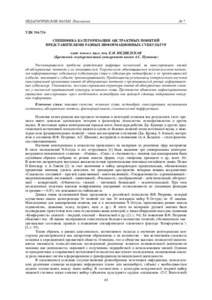Please use this identifier to cite or link to this item:
https://elib.psu.by/handle/123456789/23922Full metadata record
| DC Field | Value | Language |
|---|---|---|
| dc.contributor.author | Медведская, Е. И. | - |
| dc.date.accessioned | 2019-09-16T09:42:49Z | - |
| dc.date.available | 2019-09-16T09:42:49Z | - |
| dc.date.issued | 2019 | - |
| dc.identifier.citation | Вестник Полоцкого государственного университета. Серия E, Педагогические науки. - 2019. - № 7. - С. 65-69. | ru_RU |
| dc.identifier.uri | https://elib.psu.by/handle/123456789/23922 | - |
| dc.description | Features of Abstract Concept Categorization By Representatives of Different Information Subcultures E. Medvedskaya | ru_RU |
| dc.description.abstract | Рассматривается проблема воздействия цифровых технологий на категоризацию знаний об абстрактных понятиях у их пользователей. Теоретически обосновывается психологическая типология информационных субкультур (субкультура слова и субкультура медиаобраза) и их представителей (субъект читающий и субъект просматривающий). Представлены результаты эмпирического изучения категориальной организации знаний об абстрактных понятиях у представителей разных информационных субкультур. Установлено, что категориальная структура знаний об абстрактных понятиях сложнее у носителей традиционной культуры печатного слова. Предложено объяснение зафиксированному упрощению категоризации через особенности медиаобраза как ведущей единицы кодирования интернет-информации.= The article is devoted to the problem of the impact of digital technologies on the categorization of abstract concept knowledge of their users. The psychological typology of informational subcultures (word subculture and media image subculture) and their representatives (reader and viewer) is theoretically substantiated. The results of empirical study of the categorical organization of abstract concept knowledge among representatives of different informational subcultures are presented. It has been established that the categorical structure of knowledge abstract is more complicated in those who bear the traditional culture of the printed word. An explanation is offered to the fixed categorization simplification through the features of the media image as the leading unit for coding Internet information. | ru_RU |
| dc.language.iso | ru | ru_RU |
| dc.publisher | Полоцкий государственный университет | ru_RU |
| dc.relation.ispartof | Веснік Полацкага дзяржаўнага ўніверсітэта. Серыя E, Педагагічныя навукі | be_BE |
| dc.relation.ispartof | Herald of Polotsk State University. Series E, Pedagogical Sciences | en_EN |
| dc.relation.ispartof | Вестник Полоцкого государственного университета. Серия E, Педагогические науки | ru_RU |
| dc.relation.ispartofseries | Серия E, Педагогические науки;2019. - № 7 | - |
| dc.rights | open access | ru_RU |
| dc.subject | Государственный рубрикатор НТИ - ВИНИТИ::ОБЩЕСТВЕННЫЕ НАУКИ::Народное образование. Педагогика | ru_RU |
| dc.subject | Государственный рубрикатор НТИ - ВИНИТИ::ОБЩЕСТВЕННЫЕ НАУКИ::Психология | ru_RU |
| dc.subject | Знаковая система | ru_RU |
| dc.subject | Печатное слово | ru_RU |
| dc.subject | Медиаобраз | ru_RU |
| dc.subject | Sign system | ru_RU |
| dc.subject | Printed word | ru_RU |
| dc.subject | Media image | ru_RU |
| dc.title | Специфика категоризации абстрактных понятий представителями разных информационных субкультур | ru_RU |
| dc.type | Article | ru_RU |
| dc.identifier.udc | 316.726 | - |
| Appears in Collections: | 2019, № 7 | |
Items in DSpace are protected by copyright, with all rights reserved, unless otherwise indicated.
